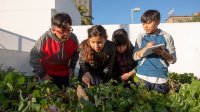Building Climate Literacy With Community Science Projects
Digital tools allow students to monitor changes in our environment over time and see the impact of climate change firsthand.
Your content has been saved!
Go to My Saved Content.When teaching a lesson on climate change, I was once approached by a student who was visibly upset about the state of our world. She asked me, “What gives you hope that things can change?” I was reminded of a quote by youth climate activist Greta Thunberg: “There is hope—I’ve seen it—but it does not come from the governments or corporations, it comes from the people. The people who have been unaware are now starting to wake up, and once we become aware we change. We can change and people are ready for change.”
Our students will be the ones to protect the future of our planet, so how do we give them hope and help them take action? How do we equip them with the tools they’ll need to take on this challenge while also maintaining optimism?
As educators, we can make a difference by teaching our students climate literacy, an understanding of how human activities influence the environment and how these changes in return have a direct impact on our society. Building climate literacy can help prepare students for their role as citizens and decision-makers so they can hopefully adapt to and mitigate the effects of global climate change. This begins with effective climate change education, which includes opportunities for students to engage cognitively, emotionally, and behaviorally.
One way to achieve this is through community science projects, in which students can monitor the changes in our environment over time and see the impact of climate change firsthand.
Engaging Minds
Climate literacy starts with helping our students understand and appreciate the scientific process. Community science projects like Nature’s Notebook and Project Budburst allow students to engage in scientific practices such as conducting research, classifying, measuring, predicting, systems thinking, and critical thinking, while simultaneously building knowledge of our climate.
These projects help model the scientific process for students. Scientists and community members are observing, uncovering comparative questions, exploring predictions, gathering data, analyzing data and sharing discoveries. In particular, Nature’s Notebook focuses on observations, and according to the National Oceanic and Atmospheric Administration, making and recording regular observations in nature through time helps us “better understand how species in our ecosystems are responding to seasonal change and to long-term climatic changes.”
These projects are designed specifically to help students build and apply 21st-century skills like making predictions, collecting and analyzing data, drawing conclusions from evidence, and sharing and communicating information. For example, students can collect phenological data like bud and flower break, fruit harvest, or leaf fall. In addition, they can gather data on life cycle changes of native species like the monarch butterfly and its host plant milkweed, and the timing of flowering and leafing with insect emergence.
By participating in Project Budburst, students can help scientists answer research questions like “How is climate change affecting plant phenology?” or “How are pollinators affected by climate change?” Both Project Budburst and Nature’s Notebook can help illustrate the phenological process, making them valuable tools to introduce students to climate change.
Engaging Hearts
By observing their community, students develop the desire to care for it. Fostering ownership of the local environment motivates climate literacy, and citizen science projects like the ones above and ISeeChange offer an opportunity for students to learn in their own communities.
ISeeChange encourages students to create posts that combine detailed stories and photos to show what they are seeing in their environment and how it is affecting them, such as how a pest species is affecting their schoolyard habitat. A community scientist here in Rhode Island, for instance, posted a photo of a bulb popping up in late January, and a cranberry farmer in neighboring Massachusetts posted about having to harvest her crop two weeks later than usual this past year.
In addition to helping improve local knowledge and research, the project helps students identify the effects of climate change in their backyards, neighborhoods, and cities, allowing students to build personal connections with their surroundings.
Engaging Hands
Our students can be active participants and agents of change in their communities, and effective climate change education empowers students to take action. Through community science projects, students can use the local data that they collect and their desire to protect what they love to inform their communities of potential solutions to local environmental issues.
For example, students might post photos of flooding events or the effects of extreme weather events in their neighborhoods, which are then shared widely by ISeeChange on social media, in newsletters, and in reports to local partners that are working on local solutions.
One of the things that I admire the most about young people is their resilience—they give me hope! We need to ensure that today’s students, the next generation of citizens, have the foundation needed to grapple with and address the challenges of global climate change with their heads, hearts, and hands.
